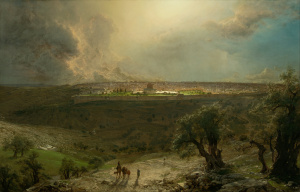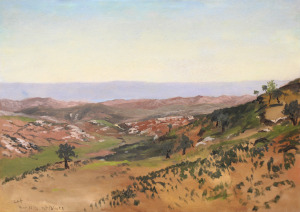The landscape painter Frederic Church built his reputation on grand exhibition paintings of awesome views that for many mid-century Americans expressed a divine presence in the world. In search of majestic scenery, he traveled to South America (1853 and 1857), Jamaica (1865), and in 1868 to 1869, he, with his wife Isabel, their young son, and his mother-in-law, traveled to Cairo, the Holy Land, Lebanon and present-day Jordan. In March 1869, he and his wife spent two weeks in Jerusalem. Like other Jerusalem visitors, Church was thrilled with the panoramic view of the Old City from the Mount of Olives. He and Isabel even camped out on the summit one night and read about Jesus praying and his betrayal on the tree-filled hillside. He purchased photographs of the panoramic scene and made a number of graphite drawings and oil sketches, including this oil sketch in preparation for his grand seven-feet-wide painting of 1870, today in the collection of the Nelson-Atkins Museum of Art, showing a panoramic view of the Old City sacred buildings in accurate detail, topped by the Dome of the Rock and the al-Aqsa Mosque, under a threatening storm-filled sky.

Jerusalem from the Mount of Olives, 1870; Frederic Edwin Church, American, 1826-1900; Oil on canvas; Nelson-Atkins Museum of Art; Enid and Crosby Kemper Foundation; F77-40/1
Church, who was familiar with the recent publications on the excavations of Jerusalem, which were understood as lending veracity of the holy sites, must have believed that by vicariously visiting one important place to the next, the viewer was re-living the biblical narrative.[i] In fact, when the painting debuted at Goupil’s Gallery in New York, Church prepared a numbered plan with all the important Christian and Islamic holy places marked. Spectators, frequently using opera glasses to catch the most minute detail, could take a virtual tour through the city.
Frederic Church’s 1867-1869 travels to Cairo, the Holy Land, Lebanon, and present-day Jordan provided the itinerary for Lockwood de Forest’s tour of the Middle East in 1875-76, when he tried to visit all the settings that Church painted previously. De Forest made an oil sketch barely indicating Jerusalem’s Temple Mount (from further back up the hill) on March 15, 1876. Painting almost ten years later than Church, de Forest was not interested in the symbolic Sacred City, but rather a more idyllic, atmospheric landscape with sunlight glinting off the white Jerusalem rocks.

“Mount of Olives,” Jerusalem, 1876; Lockwood de Forest, American, Brush and oil paint, graphite on paper board.; Courtesy Sullivan Goss, an American Gallery
===
[i] John Davis, “Frederic Church’s ‘Sacred Geography’,” Smithsonian Studies in American Art, Vol. 1, no. 1 (Spring 1987), pp.87-89.
This oil sketch will be on view in the exhibition Passion for the Exotic: Lockwood de Forest, Frederick Church beginning December 12, 2014.
Gail S. Davidson is the Head of Drawings, Prints & Graphic Design at Cooper Hewitt, Smithsonian Design Museum and co-curator of the Passion for the Exotic exhibition.
